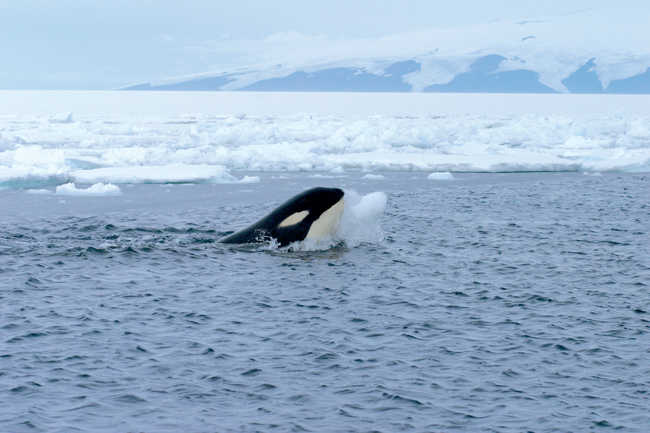Scientist Has 'Snowball Fight' With a Killer Whale

Pamplona has the Running of the Bulls, but McMurdo Sound, in the southern Ross Sea, Antarctica, has something even more spectacular: the Stampeding of the Orcas.
Each summer (December through February) an icebreaker penetrates miles into the frozen sea ice to open up a resupply channel to McMurdo Station, and the killer whales have learned to take advantage of the increased foraging area.
With my colleagues Wayne Perryman and Don LeRoi, I have come to gather evidence that McMurdo killer whales — which have distinct color patterning and prey preferences — may be a separate species. To make our case, we are collecting skin samples for DNA, taking photographs, and simply getting to know the orcas a little better in their natural environment.
We are 300 feet up in a United States Coast Guard helicopter, working our way along an extended crack in the ice that has opened off the main channel, when we spot at least thirty killer whales in a long, scattered pod. We land the helicopter a half-mile ahead, well off the ice edge, and while the rotor blades are still whop-whopping, our pilot, Lieutenant Wendy Hart, signals that it’s safe to get out. We charge across the frozen sea toward the sliver of water. As we approach, a four-foot-tall black letter opener slices across our view: the dorsal fin of an adult male killer whale. We see his small cloud of breath and, a full second after, an explosive gasp from the lung-pumping mammal reaches our ears. That kindred sound, so similar to our own labored breathing, raises the hair on the back of my neck.
When we get to the water we find it black and glassy calm. The helo has shut down and now the only sound on this frozen plain is the occasional squeak of our rubber boots in the powdery snow. But then, another blast of respiration announces that more killer whales have surfaced along the edge of the ice, ice so thick that we can walk right up to the rim of the whales’ world. The water is clear, and their white eye-patches are easy to follow as they glide beneath the surface. Another adult male, maybe eighteen feet long, surfaces three feet away; his breath fogs my glasses before I instinctively jump back. Then a cow and her new calf charge through like a train with a small caboose. The calf — young enough that it still swims in jerky motions — lifts its head clear of the water, perhaps to get a better look at the novel creatures out on the ice. The adults seem to have more pressing business elsewhere.
Yesterday we saw a pod that was in less of a hurry. One of the whales, probably an adult female, was lolling in front of us. I wanted her to know we were there, so I tossed a snowball out to her. My throw was off: it tapped her on the side, and the dry snow vaporized with a muffled “pat.” In response, she hesitated, and then, to my surprise, she started pushing around a piece of ice that was a couple of feet across. At one point she flicked it with the end of her snout, and it broke in two. She disappeared for a minute and brought back a replacement chunk of ice — about the size of a volleyball. This time, when she arched her head back and snapped it forward, the ice flew out of the water and several feet ahead. For five minutes she motored around the small pond in front of us, repeatedly launching her ball of ice, before she lost interest and went on her way. I had to wonder: Did I just show a killer whale how to throw snowballs?
Today there will be no such dallying. The thundering herd takes about five minutes to blow by us. In the commotion, I frantically alternate between camera and crossbow. The photographs will allow us to estimate how many whales there are here, and with the crossbow we take a harmless snippet of skin for genetic analysis — to determine if the Ross Sea killer whales are in fact a different species. The whales ignore our efforts, and within a few moments we are left with only our samples, our photos, and the silence once again.
Get the world’s most fascinating discoveries delivered straight to your inbox.
- Whales: News and Information
- Helicopters Collect Whale Snot from Blowholes
- Ancient Whales Gave Birth on Land
Robert L. Pitman is a marine ecologist at the Southwest Fisheries Science Center in La Jolla, California. He has spent much of the past thirty-five years at sea studying whales and dolphins around the world.
 Live Science Plus
Live Science Plus





